2023.08.03.79
Files > Volume 8 > Vol 8 No 3 2023
Physiological responses for Wheat cultivars growing under the allelopathic effect of Spinacia oleracea leaves

1,* Department of Biology, College of Science, Mosul University, Mosul, Iraq;E-mail: [email protected].
2Department of Biology, College of Science, Mosul University, Mosul, Iraq;
E-mail: [email protected].
3 Department of Biology, College of Science, Mosul University, Mosul, Iraq; E-mail: [email protected].
* Correspondence: [email protected].
Available from: http://dx.doi.org/10.21931/RB/2023.08.03.79
ABSTRACT
The research was done to study the allelopathic impact of Spinacia oleracea L. on wheat germination and growth. The wheat cultivars were Baraka, Bhooth, Ibaa99 and Sham. The allelopathic effect was determined by two experiments (laboratory and greenhouse). In the laboratory experiment, aqueous extract concentration was 2 and 4% (W: V) with Distilled water as control. Bhooth cultivars showed a high reduction rate of germination, 17.6%. The high reduction rate of germination was 17.6%, which appeared in the Bhooth cultivar. Generally, the highest reduction of plumule and radicle lengths (21.5 and 130.9) % in which cultivars were inhibited. Furthermore, the residues of S. oleracea caused a significant reduction in root length (22.4%) and (16.7%) in root dry weights. At the same time, the results revealed a clear stimulation percent in plumule length of 40.7%, radical length of 82.9%, plumule dry weight (30.5%), and radical dry weight(20%).In the greenhouse experiment, four cultivars of wheat that were cultivated in soil incubated with S. oleracea L.(2and4%, W: W) showed the highest reduction percent on seed germination in Bhooth and Sham cultivars at 2%; the results showed that wheat cultivars treated with S. oleracea at 4% were superior in length, dry weight Ibaa 99 shoot system, leaves number compared to plant without treatment.
Keywords: Allelopathy, wheat cultivars, crops, Spinacia oleracea. Seed germination
Wheat is a Poaceae family member and an economically significant agronomic crop for humans. It is widely cultivated for grains used in food and numerous other processed items. It is the world's third most extensively produced grain crop after maize and rice.1.
Allelopathy is a complicated process that can occur in both natural ecosystems and cultivated fields. It is typically thought of as a mechanism through which certain plants and bacteria can preserve their superiority over others, tolerate in a specific setting 2
Although many plants exhibit favorable allelopathic effects on the surrounding plants, residues and leachates of different crops' shoot/root growth, nutrient productivity, or may attack have been demonstrated to contain adverse effects on wheat growth. Allelopathy can, therefore, be successfully used in agriculture to increase crop productivity by eradicating or limiting susceptible species. Allelopathic interactions among plants for resources result in physiological and biochemical changes that may contribute to creating a viable plant community. 3
According to reports, some barley cultivars are phytotoxic, which could have adverse effects on the germination of bread wheat (Triticum durum) and durum wheat (T.durum and T. aestivum) . lowered root radicle and coleoptile rates when compared to several Brassica species root extension, lack of root hairs, edema, or tearing 4
(investigated the effects of eight different sunflower cultivars' air-dried leaf powder on wheat and found that higher extract levels harmed germination.
Five noticed that one plant has an advantage over another due to the metabolic compounds known as allele chemicals, which are released into the environment, either as volatile compounds, rain leachates, decomposed materials, or directly into the rhizosphere, with the potential for either positive or negative interactions with other plants and microbes. Six looked into the allelopathic effects of sugarcane (Saccharum officinale L.) cultivar 51's aqueous extracts of its roots, stem peels, and leaves at concentrations of 0,2.5,5.0,7.5, and 10.0 g/l on germination indices and seedling biomass of wheat (T. aestivum L.) cultivar nutrient 'suseable source being destroyed for the plant.
Spinach (S. oleracea L.) belongs to the Amaranthaceae family and is a leafy green flowering plant native to central and western Asia. Its leaves are a common edible vegetable consumed either fresh or after storage, and the taste differs considerably; the high oxalate content may be reduced by steaming 7
we achieved this study to demonstrate the allelopathic activity of S. oleracea L. on wheat germination and seedling growth in both laboratory and greenhouse conditions.
.
Two experiments were conducted at Mosul University, Biology Department, College of Science to investigate the allelopathic effects of Spinach (S. oleracea L.). Two methods were used to observe the allelopathic effects of S. oleracea L. cultivars on seed germination, four cultivars of wheat seed (Baraka, Ibaa 99, Bhooth and Sham) were obtained from seeds testing and confirmation center in Ninawa governorate /Iraq.
Laboratory assay
Preparation of aqueous extracts
S. oleracea L. plants were mixed and soaked for 24 hours at room temperature in distilled water (2 and 4 g per 100ml). After that, the solutions were filtered twice: once through a double layer of muslin gauze and then again through Whatman No.1 filter paper. The effect of water extracts at concentrations 2 and 4% (W: V) was evaluated in Petri dish bioassay. Four wheat cultivars (Ibaa99, Sham, Bhooth and Baraka) with ten seeds were placed in sterilized Petri dishes lined with twice-folded filter paper. In each Petri dish, 8ml of (2 and 4% W: V) of the S. oleracea extract was added, while distilled water was used in control, with three replicates in all of the treated samples. Petry dishes were incubated at 22 °C (±2) for seven days in a Completely Randomized Design (CRD). The percent of seed germination (%) was calculated in the following equation8
Germination percent =

Greenhouse Experiment
In 2021, a pot experiment was conducted at the Department of Biology's greenhouse. The effect of incubated dry plants (2 and 4% W: W) during two weeks in pots with soil was determined. Ten seeds were placed in Plastic pots with a diameter of 20cm for each of the wheat cultivars (IPA99, Sham Baraka Bhooth) at 0.5cm depth from the surface of the soil with three replicates, then irrigated with water and placed in a greenhouse at a temperature of 22(±2) °C,10 wheat seeds were sowed in the soil without residues as a control. After 60 days of seedling, the germination percentage was assessed.
Phenotypic characteristics investigation
Germination percent, shoot length(cm), dry weight of shoot (gm), number of leaves per plant, leaf area for cultivar wheat measured (2cm)
Leaf area = length × max width × 0.905 10
Average inhibition or stimulation in wheat growth was calculated to evaluate the allelopathic potential of S. oleracea L. All the selected wheat varieties were more or less detrimental to the studied characteristics of the plant.
Average inhibition or stimulation = (control-treatment) /control ×100 9
Statistical analysis
The data was statistically evaluated, and differences in treatment means were compared using the Completely Randomize Design(CRD)test at a probability level of 0.0511
The present results refer to the effect of seed germination percent of wheat cultivars after adding aqueous extraction of S.oleracea at the (2 and 4%)W: V concentrations stimulated or reduced compared to control. Optimum seed germination percent was observed in the Baraka cultivar(98.3%), whereas the highest decreasing percent (78.3%) was observed in cultivar Bhooth. From a comparison of the mean effect of concentration, seed germination decreased from (92.5 to 85) % due to additional concentration, especially with plumule and radical length with their dry weight. The aqueous extraction reduced the length of the plumule (4.69 to 4.41) cm, which led to a significant decrease at the same concentration (0.48 to 0.41) gm in the dry weight of the plumule. The highest length of plumule, 6.77cm, was documented in cultivar Ibaa99, and the highest dry weight of plumule was 0.0098gm in the Sham cultivar.
Table (1) details a significant variance in the length of the radical and its weight for all four cultivars. The study showed that the Ibaa99 cultivar revealed the highest length of radical, 9.25cm, whereas its highest dry weight was 0.0103gm for the Sham cultivar. In addition, the effect of additional percent showed a significant decreasing outcome for radical length from (8.9 to 7.07) cm. and dry weight from (0.0079 to 0.0064) cm at concentration (2%).
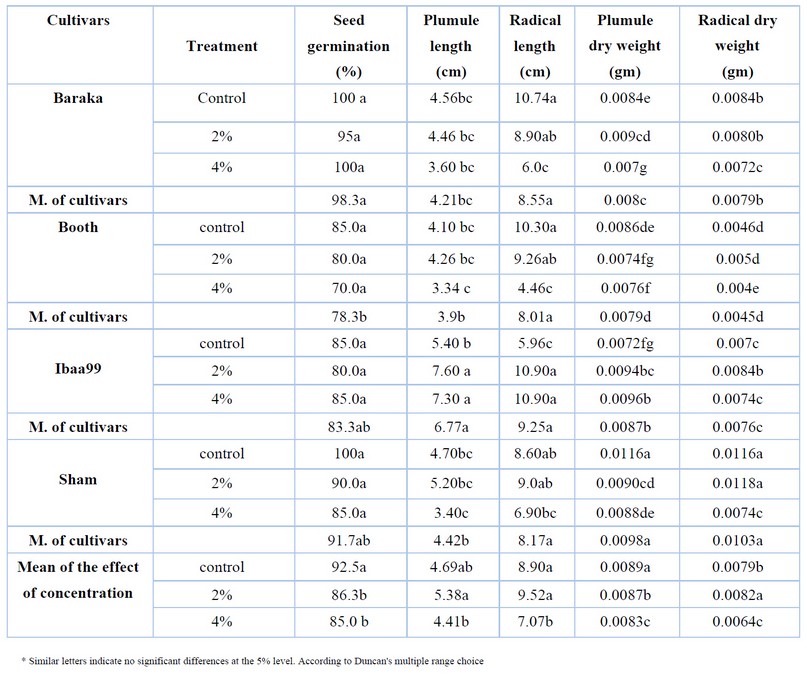
Table 1. Effect of S. oleracea L. in germination and seedling growth for wheat cultivars.
Documented information in Table 2 revealed clear values of inhibition or stimulation in comparison with control. The highest percent of reduction of germination was observed in the cultivar Bhooth (-17.65) at 4%. The high reduction percent in the plumule length was (-21.05) cm observed in the Baraka cultivar, while the percent high of stimulation was +40.74 in the cultivar Ibaa99 at 4%. On the other hand, the high reduction percent in radical length was -130.94 in cultivar Bhooth; the high stimulation percent was +82.89 in cultivar Ibba 99, and the high stimulation percent of plumule and radicle dry weight was (+30.56 +20), respectively in the cultivar Ibba99. The high percentage of inhibition in the dry weight of the plumule and radicle was -24.14 and -39.66 gm, respectively, in the Sham cultivar.
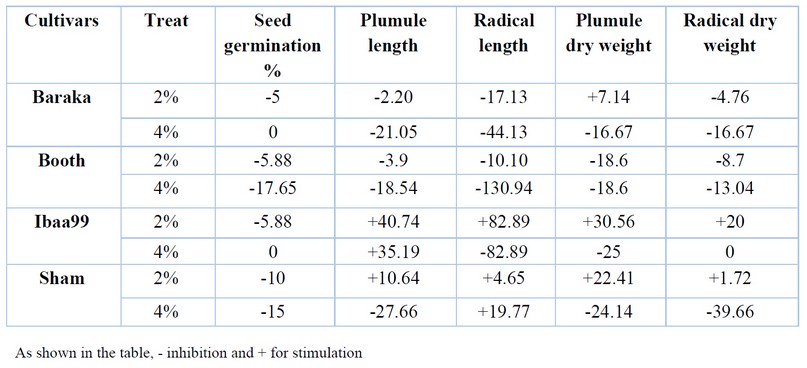
Table 2. Effect of S. oleracea L. on Average inhibition or stimulation for wheat cultivars.
As shown in the table, - inhibition and + for stimulation
Figure (1) shows the effect of S. oleracea incubated in the soil on seed germination percent of four wheat cultivars. The highest reduction percent of seed germination was documented in Bhooth and Sham cultivars in the soil with an added 2 %W: W of S. oleracea leaves.
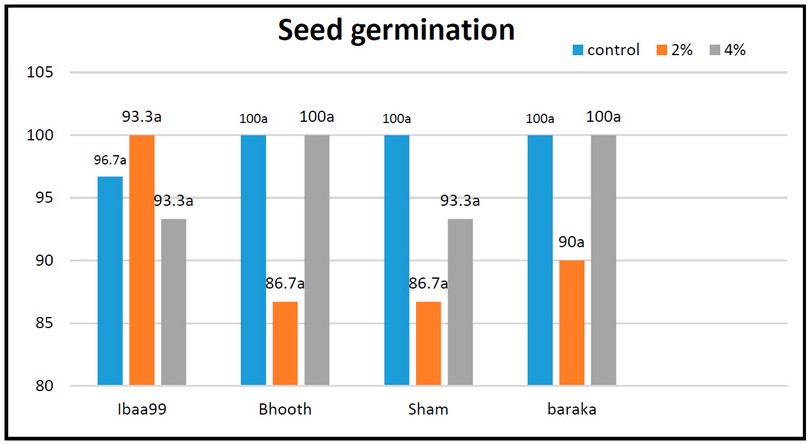
Figure 1. Effect of S. oleracea in seed germination percent % for wheat cultivars.
The four cultivars that were cultivated in the soils incubated with S. oleracea showed a variant increasing values in shoot length, although the remainder of the treatments varied in shoot length with different cultivars, the highest in shoot length linked with Baraka cultivars after treating with 2%W; W S.oleracea L. as that represented in the histogram (figure2).
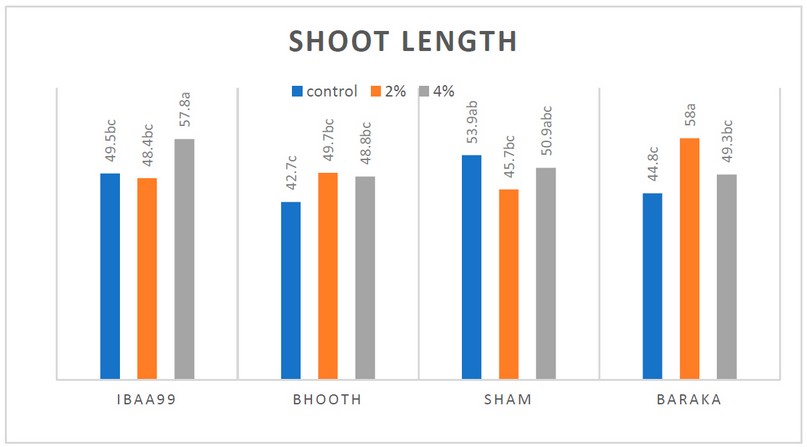
Figure. 2. Effect of S. oleracea in shoot length cm for wheat cultivars.
The present information demonstrated that the dry weight of the shoot differed according to the four wheat cultivars after being treated with soil added S. oleracea L. Cultivar Ibaa99 treated with soil have S.oleracea. At 4% w;w. showed the most significant value of dry weight (figure3).
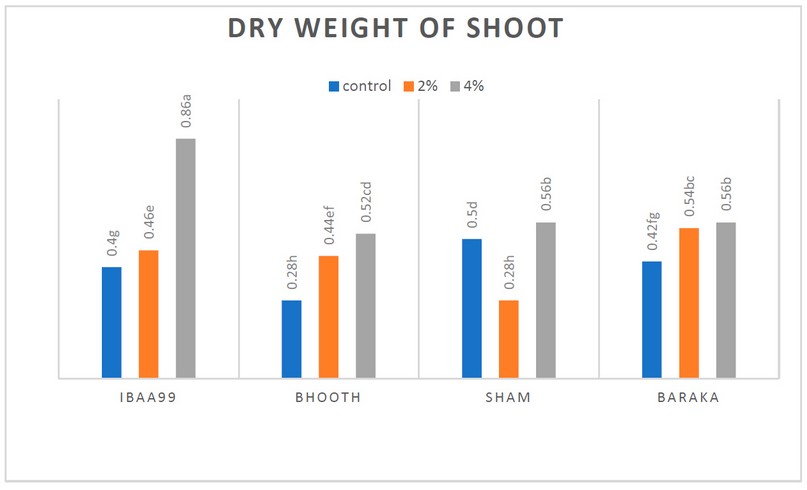
Figure. 3. Effect of S. oleracea in dry weight gm of shoot for wheat cultivars.
Figure (4) informed us that there was a variance in the number of leaves of the four wheat cultivars cultivated in the S. oleracea-containing soil compared to the number of plant leaves grown in the control soil. Leaves number of Ibaa 99 cultivar and Bhooth treated with S. oleracea aqueous extract revealed a high increasing percentage.
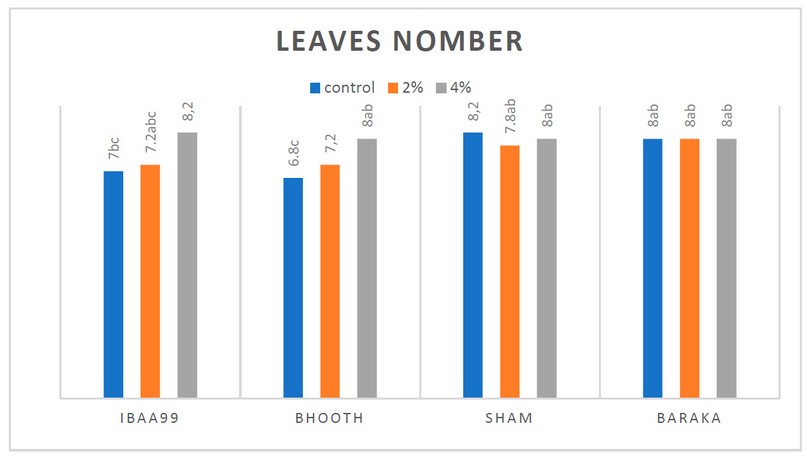
Figure 4. Effect of S. oleracea in leaves number for wheat cultivars
In the soil incubated with S. oleracea, there were changes in the leaf area in wheat cultivars, as shown in Figure (5). leaf area of Ibaa99 plants grown in soils incubated with S. oleracea at 4% W: W showed the highest increasing percent.
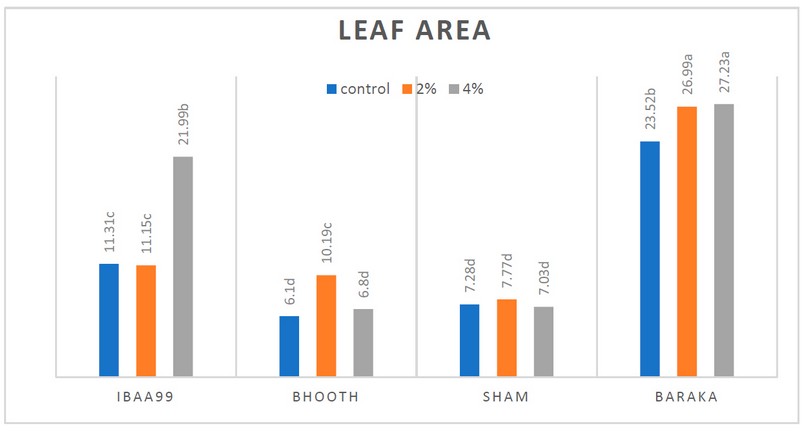
Figure 5. Effect of S.oleracea in leaf area for wheat cultivars
According to Duncan's multiple range choice, similar letters indicate no significant differences at the 5% level.
The results of allelopathic activity of S. oleracea L. noticed different effects on germination and wheat seedling growth after adding aqueous extracts of S.oleracea at ( 2 and 4%) concentrations. Inhibition occurred in the germination of wheat cultivars. The highest percent of inhibition of germination was observed in the cultivar Bhooth (17.65)%; seed germination percent was decreased from( 92.5 to 85) %; it is caused by the release of secondary metabolites such as phenolic compounds from the donor plant directly affected receiver plants12. Generally, seed germination is less sensitive to allelochemicals than seedling growth.
The reduction or stimulation in the growth of wheat cultivars was reflected in some characteristics; the results showed a reduction in the length and dry weight of plumule and radicle. The high reduction percent in the plumule length was (-27.16) cm observed in the Sham cultivar, while the high percent of stimulation was +40.74 in the cultivar Ibaa 99. The reason for the inhibitory effect may be due to the presence of some active compounds, such as alkaloids, glycosides and tannins, that work in inhibiting cell division and elongation and then reducing the length of the plumule13
The high reduction percent in radical length was 130.94 in cultivar Bhooth, and the high stimulation percent was +82.89 in cultivar Ibba 99; the reason for the results may be due to the sensitivity of the plant to the compounds liberated from the extract, which may have inhibited the root growth or may be linked to the enzymes of auxin formation, Roots are more affected than plumule due to the first to absorb the allelochemical compounds from the environment14
The high stimulation percent of plumule and radicle dry weight was (+30.56 +20) in the cultivar Ibba99. While the high percentage of inhibition in the dry weight of the plumule and radicle was 24.14 and 39.66, respectively, in the sham cultivar, It can be attributed to the release of Compounds causing inhibited activity. At the same time, we find an increase in the weight dry seedlings when treated with extract; the reason for the difference in effect may be due to the difference in the type of substance and active substances in each treatment that can act stimulatively or act in an inhibitory manner .agreeted with 15 that found that wheat seedling growth is inhibited by the aqueous leaf leachate of E. hierosolymitana,16 found that water extracts from tips, root axis curling, and increased seminal residues of the Brassica decreased roots, reduced dry weight accumulation, and plumule length of wheat.
Results of a greenhouse experiment about the effect of S. oleracea L. incupated showed the highest reduction percent of seed germination was 86.7 % in Bhooth and Sham cultivars in the soil with added 2%W: W S. oleracea L. due to the chemical compounds present in those residues, which were released into the soil as a result of biological processes in the presence of microorganisms analyzing and affect on seed germination attributed with the effect on the process of imbibition, as well as affecting the process of cell division or the enzymes that contribute to the germination process these germination process 17 plants Helianthus annuus L showed suppressive effects on germination of 20 cultivars of wheat, the inhibition that occurred by added by 1,2 and4%.
Results showed a variant increasing in shoot length values, the highest shoot length linked with Baraka cultivars after treating with 2%W: W S. oleracea L . Allelopathy is an ecological phenomenon that involves interactions between species that can have both favorable and unfavorable impacts, which may help change agricultural cultivation practices and increasing yields as a result18 the dry weight of shoot differed in four wheat cultivars. Ibaa99 cultivar treated with soil have S. at 4% W: W showed the most significant dry weight value. This may be caused by releasing a compound effect on Gebrlin acid activity or inhibiting synthesis of GA3, which regulates amylase production during seed germination 19, which are secondary metabolites produced in different plant parts, which vary according to their chemical nature and their concentrations. Also, there was a variance in the number of leaves of the four wheat cultivars grown in the S. oleracea L. Leaves; several Ibaa 99 cultivars and Bhooth revealed a high increasing value. On the other hand, there were changes in the leaf area in wheat cultivars; the leaf area of Baraka showed the highest increasing value because allelochemicals impact abiotic and biotic soil processes that impact other plants. This is comparable to earlier observations made by20
Allelochemicals are typically secondary metabolites that are found in varying concentrations in various plant parts (leaves, stems, barks, flowers, and seeds, for example), whether living or dead, through washing and analysis of plant residues in the soil by the action of microorganisms in it, which, when released into the rhizosphere, tend to change the capacity for consuming resources through a variety of mechanisms, including altering the permeability of cell membranes, changing enzymatic activity, inducing genetic reference.
Allelopathy is a complex process that can happen in both uncultivated areas and natural habitats. This research concluded that the four wheat cultivars differ in their response to the allopathic effect of S. clearance L. besides the sensitivity to the biological activity of these compounds and genetic factors between cultivars, differences, according to the concentration, the residues of S. oleracea in laboratory experiment caused significant reduction of germination, plumule and radicle lengths, dry weights, besides a clear stimulation percent in plumule length and radical length, plumule dry weight, radical dry weight in comparison to plants without treatment, the results in greenhouse showed that wheat cultivars treated with S. oleracea at 4% had superior length, dry weight shoot systems, and leaf number in Ibaa 99, also reported that of allelochemicals concentration. The (Ibaa99) variety has more sensitivity to which concentration.
Funding: "This research received no external funding,"
Acknowledgments: The author would like to thank the Dean and Head of the Department of Biology at the College of the Science / University of Mosul for providing all the facilities to complete this research.
Conflicts of Interest: "The authors declare no conflict of interest."
1. FAO. Food and Agricultural Organization of United Nations, Roma. Available online: (accessed on 31 January).2022.
2. Wu, H.; An, M.; Liu, D.; Pratley, J and Deirdre, L. Allelopathy in Sustainable Agriculture and Forestry, Acta agriculture Slovenica,2017, 235–254.
3. Al-Doree, E. K.; Al-Sffar, R. S. and Jasim I. r. Phenotypic and genotypic investigation of three weeds residues allelopathic effect on the growth of three hybrid wheat cultivars.j. Bionatura:2022, V.7 4 64. DOI i.org/10.21931/RB/2022.07.04.64.
4. Ben-Hammouda, M.; Ghorbal, H.; Kremer, R.J. and Oueslati, O..Allelopathic effects of barley extracts on germination and seedlings growth of bread and durum wheat. Agronomie.,2001, 21: 65-71.
5. Cheng, F. and Cheng, Z. Research progress on the use of plant allelopathy in agriculture and the physiological and ecological mechanisms of allelopathy. Front Plant Sci:2015, 6:102003. DOI org/10.3389/fpls.2015.01020.
6. Majeed, A.; Chaudhry, Z. and Muhammad, Z. Allelopathic assessment of fresh aqueous extracts of Chenopodium album L. for growth and yield of wheat (Triticum aestivum L.). Pak. J. Bot,2012, 44(1), 165-167.
7. UN Food & Agriculture Organization. Retrieved American-Eurasian J. Agric. & Environ. Sci..,2018, 7 (3): 298-302.
8. ISTA. International rules for seed testing. Seed Science and Technology:1976,4: 1-161.
9. Chung, I.M.; Ahn, JK and Yun, S.J. Assessment of allelopathic potential of Coastal Bremoda grass.Agro.J.,2001,80:557-560.
10. Kemp, C. D. Methods of estimating the leaf area of grasses from linear measurements. Annals of Botany:1960, 24(4), 491-499.
11. Drebee, H. A.The Effect of Cultivated Area and the Prices of Buying the Rice on Its Production in AL-Qadisiyah Province-Iraq During (1990-2014) by Using VECM. Al-Qadisiyah Journal For Agriculture Sciences:2017, 7(1), 102-113.
12. Yang, Li.; Kui-Shan, Wen.; Xiao, R.; Ying-Xian, Z.; Feng, W.; Qiang, W.* and Helen, D. S. Academic Editor and Marina Sokovic, Academic. Response of Plant Secondary Metabolites to Environmental Factors. Molecules. Apr;2018, 23(4): 762. doi: 10.3390/molecules23040762.
13. Masood, S.; Rehman, A. U.; Bashir, S.; Imran, M.; Khalil, P.; Khursheed, T. and Javaid, N. Proximate and sensory analysis of wheat bread supplemented with onion powder and onion peel extract. Bioscience research;2018.
14. Turk, M. A. and Tawaha, A. M. Allelopathic effect of black mustard (Brassica nigra L.) on germination and growth of wild oat (Avena fatua L.). Crop protection;2003, 22(4), 673-677.
15. Abu-Romman, S.;Shatnawi, M.; Shibli, R. Allelopathic effects of spurge (Euphorbia hierosolymitana) on wheat (Triticum durum). American Eurasian Journal of Agricultural & Environmental Sciences;2010, 7(3), 298-302.
16. Mason-Sedun, W.; Jessop, R.S. and Lovett J.V. Different phytotoxicity among species and cultivars of the genus Brassica to wheat. I. Laboratory and field screening of species. Plant Soil;1986, 93: 3-16.
17. Rice, E. L. Allelopathy, 2nd edn Academic Press. New York, USA;1984.
18. Singh,M..Phenolic acids affect allelochemicals in allelopathy. Agron. J;2008 88: 886-893.
19. Barto EK, ; Hilker, M. ; Mueller, F. ;Mohney, BK.; Weidenhamer ,J.D..and Rillig, M.C. The fungal fast fane: common mycorrhizal networks extend bioactive zones of allelochemicals in soils. Plos One;2011 6:2719
20. Majeed, A., and Muhammad, Z. Salinity: a major agricultural problem—causes, impacts on crop productivity and management strategies. In Plant abiotic stress tolerance;2019 83-99 Springer, Cham.
Received: 25 June 2023/ Accepted: 26 August 2023 / Published:15 September 2023
Citation: Jasim I R, AL-Saffar R S, Mohamad Salih F k. Physiological responses for Wheat cultivars growing under the allelopathic effect of Spinacia oleracea leaves. Revis Bionatura 2023;8 (3) 79. http://dx.doi.org/10.21931/RB/2023.08.03.79.